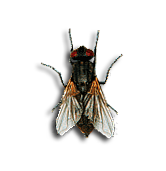General Characteristics:
- Eyes reddish; mouthparts sponging; dorsum of thorax with four narrow black stripes
- Adult body length 6-7 mm; female usually larger than male, larva 3-12 mm, pupa to 8 mm
- Abdomen gray or yellowish with dark midline and irregular dark markings on sides; underside of male yellowish
- Larva: body whitish, cylindrical, tapering toward head; head with pair of dark hooks; posterior spiracles slightly raised, and spiracular openings are sinuous slits completely surrounded by oval black border
- Pupa: color varies from yellow, red, brown, to black as pupa ages
Reproduction:
- Overwinters as a larva or pupa under manure piles or in other protected locations.
- During summer, the life cycle can be completed in 7 to 10 days, and up to 12 generations may occur in one summer.
- Eggs are laid singly but pile up in small masses. Each female fly can lay up to 500 eggs in several batches of 75-150 eggs, each over a 3 to 4 day period.
- The larvae (maggots) emerge within 8 to 20 hours, and immediately feed on the material where the eggs were laid, developing through 3 instars.
- Full-grown larvae crawl up to 15 metres to a dried cool place near breeding material, and transform into the pupal stage. Adults usually live 15 to 25 days.
Signs of Infestation:
- Common to abundant around homes, poultry & dairy farms, stables, garbage dumps, and other sources of rotting plant or animal matter; adults are inactive at night, often resting on ceilings in buildings, or on vegetation outdoors
- Adults feed on fresh and fermenting/rotting food, and garbage; adult mouthparts allow ingestion of liquid food only; solid materials are liquefied by means of regurgitated saliva
- Larvae feed on moist material rich in organic matter where eggs were laid: manure, rotting plant or animal tissue, garbage
Control Techniques:
- Close and seal as many openings as possible through which the flies can enter. This procedure is time consuming and may require a dedicated long term effort.
- Use a compressed air sprayer to apply a surface spray to surfaces in attics, basements, closets, store rooms and other areas where the flies congregate.
- Using a pyrethrin aerosol for treating cracks and crevices will compliment your surface spray
- Insecticides such as dusts, wet table powders, microencapsulated products, or aerosols may be used ACCORDING TO LABEL SPECIFICATIONS AND IN ACCORDANCE WITH FEDERAL, PROVINCIAL AND MUNICIPAL LAWS
Please click here to contact a Focus Pest Control professional to inquire about further treatments for this pest species.
References:
Rognes, Dr Knut; Pape, Dr Thomas (19 April 2007). "Taxon details: Calliphoridae" (HTML). Fauna Europaea version 1.1,. http://www.faunaeur.org/full_results.php?id=10892. Retrieved 2008-05-31.
“Genus Pollenia- Cluster Fly” (On-line). Iowa State University Entomology. Accessed Jan.
6, 2010 at http://bugguide.net/node/view/39559.
Disclaimer:
The Focus Pest Control ‘Pest Library’ is an educational resource written largely to educate the general public about common pests in Ontario. The Focus ‘Pest Library’ does not include all species in Ontario, nor does it include the most recent scientific data about species we describe. Though we edit our accounts for accuracy, we cannot guarantee all information in those accounts. While Focus Pest Control staff and contributors provide references to books and websites that we believe are reputable, we cannot necessarily endorse the contents of references beyond our control.
(Back to top)
|


